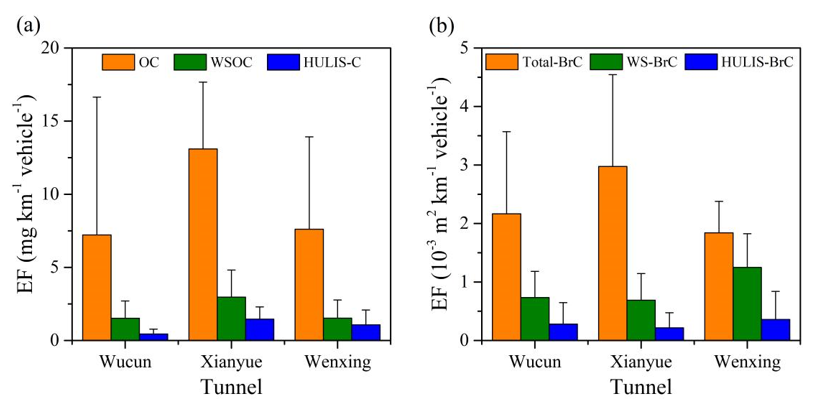Huang, R.J.*, Yuan, W., Yang, L., Yang, H., Cao, W., Guo, J., Zhang, N., Zhu, C., Wu, Y., Zhang, R.: Concentration, optical characteristics, and emission factors of brown carbon emitted by on-road vehicles, Sci. Total Environ., 810, 151307, 2022.
Brown carbon (BrC), the light-absorbing component of atmospheric organic aerosols, has recently attracted attention due to its effects on atmospheric environments, human health, and climate. The optical properties and sources of BrC, however, are still not well understood.
A research group led by Prof. HUANG Rujin from the Institute of Earth Environment (IEE) of the Chinese Academy of Sciences studied the concentrations, optical properties, and emission factors of organic carbon (OC), water-soluble OC (WSOC), and humic-like substances (HULIS) in fine particulate matter (PM2.5) emitted from vehicles in three road tunnels (the Wucun, Xianyue, and Wenxing tunnels in Xiamen, China).
The mass concentrations and light absorption of OC, WSOC, and HULIS were higher at the exits of each tunnel than at entrances, demonstrating that vehicle emissions were a BrC source.
At each tunnel's exit, the average light absorption contributed by HULIS-BrC to water-soluble BrC (WS-BrC) and total BrC at 365 nm was higher than the corresponding carbon mass concentration contributed by HULIS (HULIS-C) to WSOC and OC, indicating that the chromophores of HULIS emitted from vehicles had a disproportionately high effect on the light absorption characteristics of BrC. The emission factors (EFs) of HULIS-C and WSOC mass concentrations were highest at the Xianyue tunnel; however, the EFs of HULIS-BrC and WS-BrC light absorption were highest at the Wenxing tunnel, indicating that the chromophore composition of BrC was different among the tunnels and that the mass concentration EFs did not correspond directly to the light absorption EFs.
This study, published in Science of the Total Environment, highlighted the important contribution of vehicle emissions to BrC in atmospheric fine particles.

Fig.1 Average light absorption coefficient at wavelength between 300 to 600 for total-BrC, WS-BrC and HULIS-BrC at exits and entrances of Wucun, Xianyue and Wenxing tunnels.

Fig.2 Mass concentrations emission factors (a) of OC, WSOC and HULIS-C, and light absorption emission factors (b) of total-BrC, WS-BrC and HULIS-BrC at 365 nm in Wucun, Xianyue and Wenxing tunnels.

